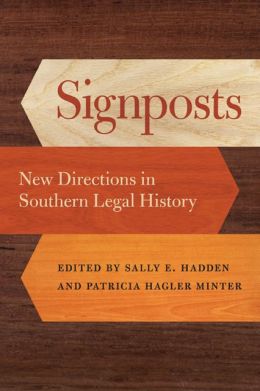 by Sally E. Hadden and Patricia Hagler Minter (eds.). Athens, Ga.: The University of Georgia Press, 2013. 480pp. Cloth $69.95 ISBN 978-0-8203-4034-0. Paperback $26.95, ISBN 978-0-8203-4499-7.
by Sally E. Hadden and Patricia Hagler Minter (eds.). Athens, Ga.: The University of Georgia Press, 2013. 480pp. Cloth $69.95 ISBN 978-0-8203-4034-0. Paperback $26.95, ISBN 978-0-8203-4499-7.Reviewed by Walter F. Pratt, Jr., University of South Carolina School of Law.
pp.473-474
Professors Hadden and Minter have given us a rich smorgasbord of essays on legal history. (“Cafeteria” might be a better term, since with it would go the assurance that sweet tea would be at the end of the exceptional menu items. But that discussion is for another day.) Rare would be the person who failed to find something of value from this collection of seventeen essays. In time, the individual articles range from the early seventeenth century to examination of civil rights issues in the late twentieth century. In approach, they range from deep involvement with personal letters to shedding new light on an old topic such as secession. In person, they range from judges in French New Orleans, whose creativity in punishments was, I suppose, to be admired to those who put their own lives at risk in the mid-twentieth century in an effort to ensure that higher education was not to be denied on the basis of race. Finally would come the literature surveys in the notes for each essay. The notes exhibit the best of collegiality among scholars, for they both provide authority for statements in the text and point the reader toward new, complimentary topics.
The Faulknerian cast given us by the collection of essays is grand in the best sense of the theater. In an essay on the Cherokee removal we find an attorney whose sense of proper conduct apparently did not reach those who represented both sides in that set of events. In another essay, we meet a number of women for whom Prohibition was but a hindrance to their trafficking in alcohol. We also meet attorneys who worked on a national stage. One challenged Reconstruction statutes as violations of the rule of law; others supported those who argued that secession was constitutional and still others who sided with those who claimed that they had a right to discriminate. What we do not see is any instance in which application of the adjective achieved an explanatory goal. None of the essays offers anything like “I’m Southern, What did you expect me to do ?” All of the essays assumed a geographical meaning to “Southern” – no one seemed to need a justification for inclusion of an essay on Kentucky.
Thus, the challenge that remains, is “Southern.” Is it like its distant cousin, “Western,” silently moving across the landscape in our minds, only to be declared obsolete by a census report no longer with us ? Both “Southern” and “Western” lack a fixed point in geography which marks the edge of space to which the term applies. For legal historians (anthropologists all), “Southern” has had a meaning something like “not Massachusetts.” [*474] That usage dates to the early years of developing a discipline of “legal history.” Among the pioneering scholars of that period there were some who used the word “American” when their research was almost exclusively in the archival collections of Massachusetts or New England.
What both terms do have is an evocative attachment to a style of life, a style no longer with us.
For Southerners, however, that style cannot be separated from slavery, continuing on into disastrous race relations. In one sense, then, essays that attempt to portray “Southern” as part of the national legal environment tend to remove the stigma of slavery. In another sense, one filled with irony: Success in placing the “Southern” stories within a national account removes all value to the adjective “Southern.”
The essays by the two editors provide examples of both the best in research and the difficulties of placing the events on a stage known as “Southern.” Professor Hadden’s essay is titled “South Carolina’s Grand Jury Presentments.” She concentrates on the eighteenth century, in particular, the last quarter of that century. What she finds is a host of activities running beside the usual oversight of prosecutorial activities. With these “presentments” the grand jury more closely resembled an inspector general whose remit was to identify inadequacies and press for their correction. As Professor Hadden notes, this portion of the grand jury’s activities ranged wide – from noting the inappropriate conduct of a private citizen to complaining about the need to repair public roads. With this sweeping ambit, the grand jury helped create a “popular legal culture” in the state.
Professor Minter’s essay reaches into the twentieth century to offer a reconsideration of BUCHANAN V. WARLEY. In that 1917 decision, the Supreme Court of the United States declared unconstitutional an ordinance of Louisville, Kentucky. The ordinance prohibited the sale of property to African Americans if the property was in a “white” neighborhood. Professor Hadden places the case itself in a much wider frame than one that emerges from a linear progression toward Brown. In so doing, she notes the importance of local citizens working with national organizations such as the NAACP – an achievement not unlike her co-editor’s description of a special legal culture, one likely to be missed by scholars pressing on toward the second half of the twentieth century.
Both essays exemplify what is especially valuable about many of the other essays in this collection: They take a familiar landscape and offer us a fresh, often different, viewpoint. With the new comes an opportunity to place the event in a different narrative tradition. What the essays do not do is place the event in a narrative that is “Southern.” And, of course (again), therein lies the problem.
CASE REFERENCE:
BUCHHANAN V. WARLEY
Copyright 2013 by the Author, Walter Pratt.